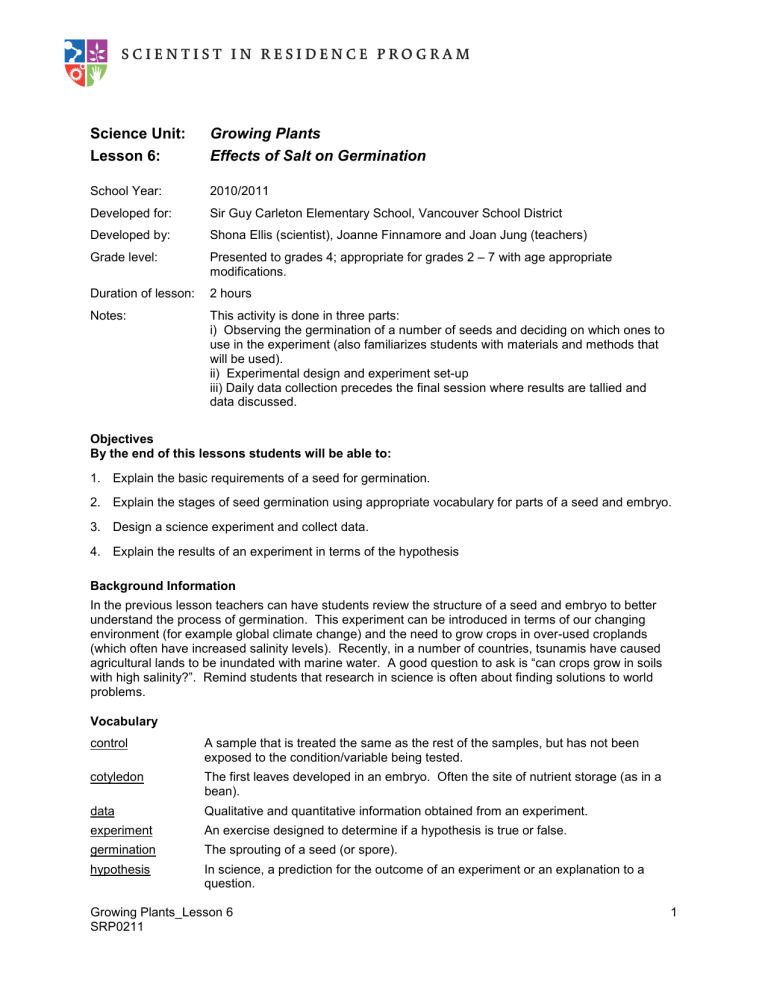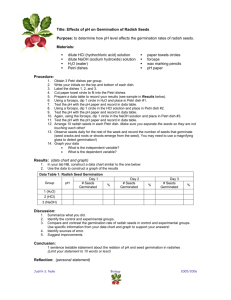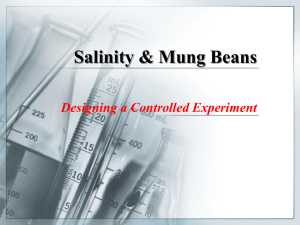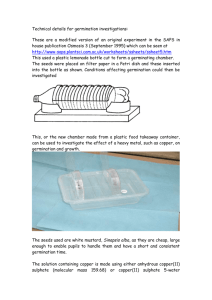Effects of Salt on Germination - Scientist in Residence Program

Science Unit: Growing Plants
Lesson 6:
School Year:
Effects of Salt on Germination
2010/2011
Developed for: Sir Guy Carleton Elementary School, Vancouver School District
Developed by:
Grade level:
Shona Ellis (scientist), Joanne Finnamore and Joan Jung (teachers)
Presented to grades 4; appropriate for grades 2 – 7 with age appropriate modifications.
Duration of lesson: 2 hours
Notes: This activity is done in three parts: i) Observing the germination of a number of seeds and deciding on which ones to use in the experiment (also familiarizes students with materials and methods that will be used). ii) Experimental design and experiment set-up iii) Daily data collection precedes the final session where results are tallied and data discussed.
Objectives
By the end of this lessons students will be able to:
1. Explain the basic requirements of a seed for germination.
2. Explain the stages of seed germination using appropriate vocabulary for parts of a seed and embryo.
3. Design a science experiment and collect data.
4. Explain the results of an experiment in terms of the hypothesis
Background Information
In the previous lesson teachers can have students review the structure of a seed and embryo to better understand the process of germination. This experiment can be introduced in terms of our changing environment (for example global climate change) and the need to grow crops in over-used croplands
(which often have increased salinity levels). Recently, in a number of countries, tsunamis have caused agricultural lands to be inundated with marine water. A good question to ask is “can crops grow in soils with high salinity?”. Remind students that research in science is often about finding solutions to world problems.
Vocabulary control cotyledon data experiment germination hypothesis
A sample that is treated the same as the rest of the samples, but has not been exposed to the condition/variable being tested.
The first leaves developed in an embryo. Often the site of nutrient storage (as in a bean).
Qualitative and quantitative information obtained from an experiment.
An exercise designed to determine if a hypothesis is true or false.
The sprouting of a seed (or spore).
In science, a prediction for the outcome of an experiment or an explanation to a question.
Growing Plants_Lesson 6
SRP0211
1
observation radicle replicate seed coat treatment
To watch and record something that is happening, such as a natural phenomenon.
Embryonic root.
A repeat of an experiment to collect more data.
The protective outer layer of a seed.
The condition being tested.
Day 1 – Preliminary Study
A variety of seeds are germinated so students can practice setting up germination chambers (Petri dishes with paper on the bottom) as well as to determine which seeds would make the best candidate for the experiment. Seeds that germinate quickly and have a high germination rate are the best subjects for the experiment.
Materials:
Variety of seeds (radish, pumpkin, sunflower, sweet pea, etc)
Petri dishes
Filter paper to line Petri dishes
Water
Pen (Sharpie)
Sterile water in Erlenmeyer flask
Each group of three students will choose among a variety of seeds. They will place 4 – 6 seeds in one
Petri dish on the dampened filter paper (or paper towel). They will label the Petri dish with their group name (along edge so they can observe through top of Petri dish. Students decide on the placement of the Petri dish (should be where they are planning to run their experiment). They will make daily observations.
After one week they will share their observations with the rest of the class and decide on which seed(s) to use for their experiment. The seeds that have not germinated or have exhibited low germination rates will be disqualified from the experiment.
Day 2 – Setting up the Experiment
As students discuss the following, draw flowchart on the board/flipchart
1. Review the basic steps of germination
2. Recap observations about germination.
3. Question: Will plants germinate in salt water?
4. What do they predict? “Seeds will not germinate in salt water” – in science this is called a
hypothesis
5. Testing the hypothesis: do an experiment.
Growing Plants_Lesson 6
SRP0211
2
On Board:
OBSERVE
ASK QUESTION
DO BACKGROUND RESEARCH
SCIENTIFIC PREDICTION = HYPOTHESIS
TEST HYPOTHESIS - EXPERIMENT
COLLECT DATA
ANALYZE RESULTS
AND MAKE CONCLUSIONS
HYPOTHESIS TRUE HYPOTHESIS FALSE
(or partially true)
Note to teacher: A simple experiment would be to test the seeds using high salt concentration only (no germination will result). In 1/100 salt concentration of marine water some seeds will germinate. In fact depending on the seed there may be an enhancement of growth in the low salt solution.
Control treatment
Test treatments
Seeds germinated in fresh water
A. Seeds germinated in low salt solution – 0.35 g/l
B. Seed germinated in high salt solution – 35 g/l (same as water from the ocean)
Experimental Design:
Materials
Quantities to be adjusted depending on class size
•
Seeds (radish, sunflower, sweet pea, etc)
•
Petri dishes
•
Filter Paper (or paper towel cut in circles to fit bottom of plastic Petri dishes)
•
plastic droppers
•
fresh water (bottled)
•
solution of low salt water - 0.35g table salt/ 1 litre bottled water
•
solution of low salt water (35g table salt/ 1 litre bottled water)
•
Sharpie marker
Growing Plants_Lesson 6
SRP0211
3
Method:
- Each group of three students receives three Petri dishes (with filter paper or paper towel lining the bottom), three different solutions (water, low salt, high salt), three droppers, and seeds to be tested.
- Each student in the group is assigned one treatment.
- Each student labels his/her Petri dish with their group name and the treatment they are responsible for: C (control), LS (low salt), and HS (high salt)
- The solutions are applied to the appropriate Petri dish so that paper is very wet.
4 – 6 seeds are placed in each Petri dish.
- Wet filter paper with water. Place four-six seeds in each Petri dish (number depends on seed size and student observations)
- Place the plates under the same conditions
- Daily observations are made and solutions are added when needed
Daily Data Collection: examine the Petri dishes and record any changes on Data Collection Sheet (last page).
After one week (may be modified depending on seed germination) the class compiles their observations.
Recording germination can be done by ranking the seedling based on size: 0 no growth to 3 best growth.
Additional observations can be made.
CLASS OBSERVATIONS:
CONTROL (WATER) LOW SALT (0.35g/l) HIGH SALT (35g/l)
SEED: ________
SEED: ________
SEED: ________
Closure Discussion
1. What is the effect of high salt on seed germination? Is the hypothesis true or false based on this result?
2. What is the effect of low salt on seed germination? Is the hypothesis true or false based on this result?
Growing Plants_Lesson 6
SRP0211
4
3. The results will be different for low and high salt concentrations. Salt is a nutrient at low concentrations and can result in enhanced growth in some seeds.
4. Which plants do you think require higher salt concentrations to germinate (plants that live near or in marine habitats).
5. What do these results tell us about growing crops that have low to high salt concentrations.
6. If you had land that has experienced a tsunami what would you do if you wanted to grow crops on it?
(find seeds that could grow on it – run and experiment with a number of different seeds (further discussions could include cause and effect).
References
1. Griffiths, Anthony 1999. Kidscience: Real Science your child can do APASE, Vancouver.
2. < http://jstait.addr.com/sunflowers/howto.htm> The Sunflower Stop's Home Guide To Growing
Sunflowers. Accessed August 18, 2008.
3. < http://wolfweb.unr.edu/homepage/crowther/ejse/rillero.html> Raphanus sativus, Germination, and
Inquiry: A Learning Cycle Approach for Novice Experimenters. Accessed Aug. 18, 2008.
Extension of Lesson Plan
1. Look at impacts of salt to living tissue.
2. Students can see if there is any difference between root and shoot growth.
Growing Plants_Lesson 6
SRP0211
5
DAY 5
DAY 6
DAY 3
DAY 4
DATA COLLECTION SHEET:
CONTROL (WATER)
DAY 1
DAY 2
LOW SALT (0.35g/l) HIGH SALT (35g/l)
Growing Plants_Lesson 6
SRP0211
6




